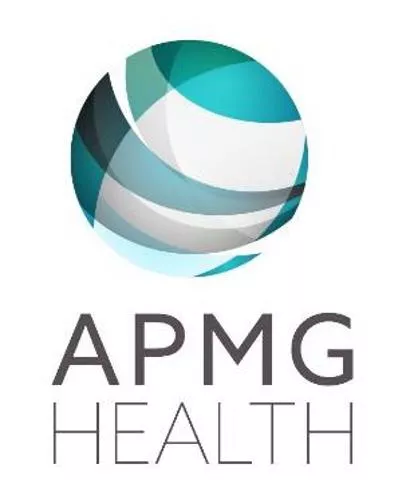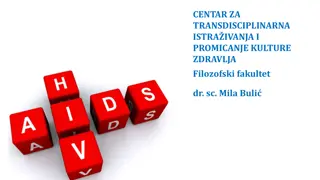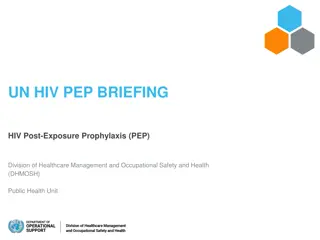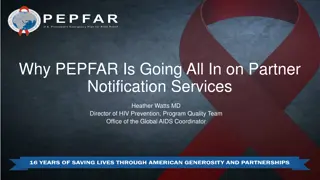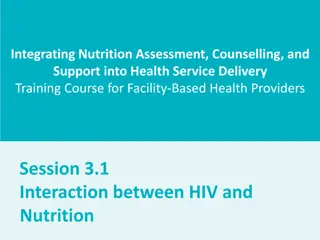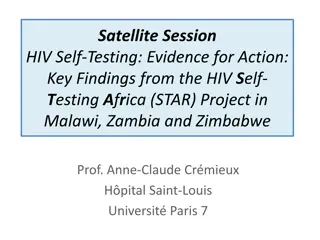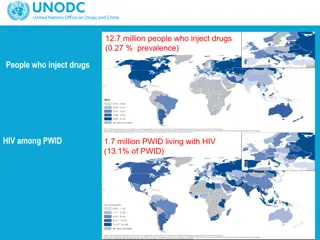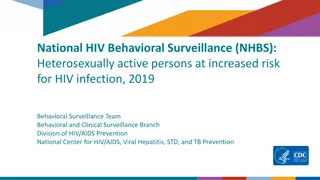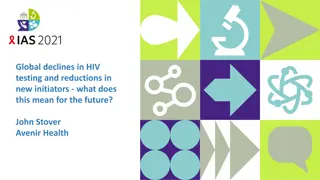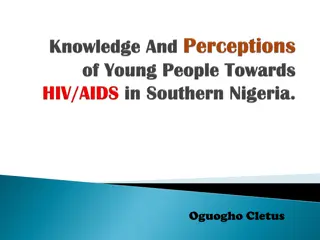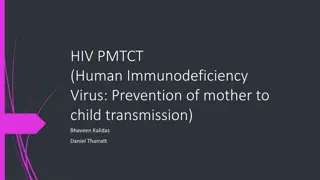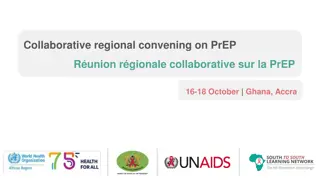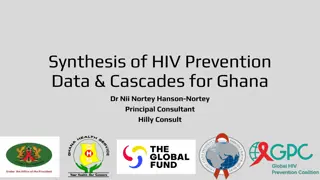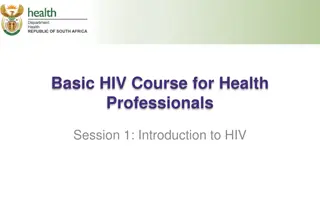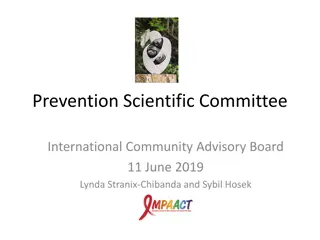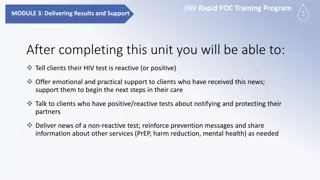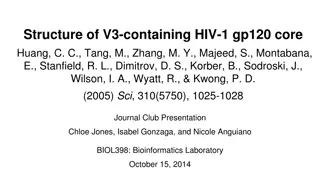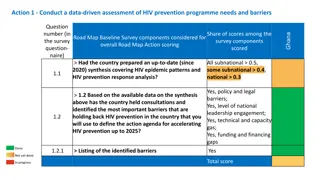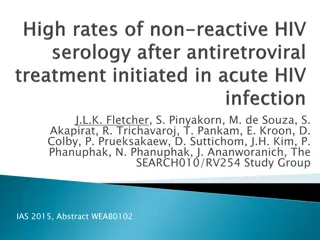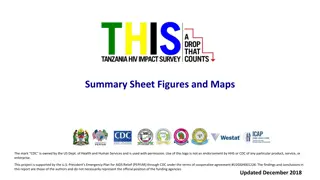Core Issues in HIV Prevention Among Key Populations
Understanding the challenges in HIV prevention among key populations, such as gay men, sex workers, people who inject drugs, transgender individuals, and prisoners. Highlighted are the increased risks of HIV acquisition within these groups and the importance of tailored service packages recommended by global health organizations.
Download Presentation

Please find below an Image/Link to download the presentation.
The content on the website is provided AS IS for your information and personal use only. It may not be sold, licensed, or shared on other websites without obtaining consent from the author. Download presentation by click this link. If you encounter any issues during the download, it is possible that the publisher has removed the file from their server.
E N D
Presentation Transcript
Core issues in HIV prevention among Key Populations Dave Burrows Tuesday, 25 September 2018 Geneva, Switzerland
Overview Why key populations? Recommended service packages Global Fund study on service packages Core issues 2
Stef Barals final slide: Plenary, AIDS 2018 HIV is not Zika The risks for HIV are not evenly distributed in any population anywhere in the world Move away from the term general population Understanding who and why people are at risk for and living with HIV can support improved individual services and larger scale program implementation
Key Populations Gay and other men who have sex with men Sex workers: female, male and transgender People who inject drugs Transgendered people Prisoners
Miles to GO: UNAIDS Update 2018 40% of new HIV infections globally in 2017 among key populations and their sexual partners Risk of HIV acquisition among gay men and other men who have sex with men 28 times higher than among heterosexual men. people who inject drugs 22 times higher than for people who do not inject drugs, female sex workers 13 times higher than adult women aged 15 49 years, and 13 times higher for transgender women than adults aged 15 49 years
Key Population Service Packages WHO (2016) Consolidated guidelines on HIV prevention, diagnosis, treatment and care for key populations SWIT (2013) Implementing Comprehensive HIV/STI Programmes with Sex Workers developed by WHO in collaboration with international partners UNODC (2013) HIV prevention, treatment and care in prisons and other closed settings developed with international partners MSMIT (2015) Implementing Comprehensive HIV and STI Programmes with Men Who Have Sex with Men developed by UNFPA in collaboration with international partners TRANSIT (2016) Implementing Comprehensive HIV and STI Programmes with Transgender People developed by UNDP in collaboration with international partners IDUIT (2017) Implementing Comprehensive HIV and HCV Programs with People Who Inject Drugs developed with the support of UNODC
Essential Health Sector Interventions Comprehensive condom and lubricant programming Harm reduction interventions for substance use, in particular needle and syringe programs and opioid substitution therapy Behavioral interventions HIV testing and counseling HIV treatment and care Prevention and management of co-infections and other comorbidities, including viral hepatitis, TB, and mental health conditions Sexual and reproductive health interventions
Essential Strategies for an Enabling Environment Supportive legislation, policy, and financial commitment, including decriminalization of behaviors of KP Addressing stigma and discrimination Community empowerment Addressing violence against people from key populations
UNAIDS Guidance UNAIDS (2015) Fast-tracking Combination Prevention UNAIDS (2017) HIV Prevention 2020 Road Map
Global Fund study on KP Service Packages Review the design, implementation and monitoring of the delivery of intervention service packages for key populations in the continuum of prevention, testing, care and treatment since 2013. Desk reviews carried out of KP Service packages for 5 KP in 65 countries In-country visits for more detailed reviews of 2-3 KP service packages in 32 countries Country, six regional and global reports 11
KP packages Assessed In-Country MSM FSW PWID TG Prisoners None Afghanistan Indonesia Nepal Pakistan Philippines Belarus Georgia Kosovo Moldova Ukraine Angola Kenya Madagascar Malawi South Africa DR Guatemala Guyana Haiti Peru Morocco Sudan Benin Cameroon Mali Sierra Leone Togo Tunisia Indonesia PNG Armenia Kyrgyzstan Uzbekistan Angola Kenya Madagascar Malawi South Africa Guyana Haiti Morocco Sudan Benin Cameroon Mali Sierra Leone Togo Afghanistan Nepal Pakistan Armenia Belarus Georgia Kosovo Kyrgyzstan Moldova Ukraine Uzbekistan Kenya Morocco Sierra Leone Indonesia Nepal PNG Philippines DR Guatemala Peru 12
Global Fund study on KP Service Packages This approach has been substantially successful More countries have identified key populations for programming within their National Strategic Plans More countries are implementing specific interventions to KP for HIV prevention, testing, treatment, and care and to address human rights barriers and co-morbidities Few of the implemented activities lie outside the list designated by WHO and other agencies as evidence-based HIV-related interventions More countries know more about KP including population sizes, characteristics of KP , how to reach and provide prevention products to KP With more funding from international donors (and some increase in domestic funding), more countries are reaching more KP with appropriate services and can measure the reach and coverage of these interventions 13
Global Fund study on KP Service Packages Looked separately at issues related to: Design: whether KP packages in NSP or supported by Global Fund grants are appropriate to epidemiological contexts, in line with international standards and guidelines (WHO 2016). Implementation: whether KP packages are reaching intended target groups, including, coverage, quality and whether these programs are available, accessible and utilized by KP. Monitoring: whether the framework, monitoring tools and mechanism set up by implementation partners are appropriate to local contexts, and are used effectively to regularly report on programmatic coverage. 14
Elements included in national designs - SW 100.00% 92.30%90.80% 89.20% 90.00% 80% 80% 76.90% 80.00% 64.60% 70.00% 60.00% 47.70% 50.00% 40.00% 29.20% 30.00% 21.50% 20% 20.00% 10.00% 0.00% 15
Design Analysis Individuals from and organizations run by key populations need to be fully involved in designing service packages Lack of or inadequate definitions of coverage for most interventions Some key populations are not recognized in national documents; some are recognized but no package is designed Lack of lubricant to accompany condom programming across populations (some exceptions in MSM packages) Inadequate inclusion of needle-syringe programs and opioid substitution treatment for PWID and prisoners 16
Design Analysis New elements have not included in the majority of countries: PrEP and overdose prevention Community empowerment is rarely mentioned in design documents Activities to reduce the most prominent human rights barriers need to be included in designs HTC and ART particularly important to reach 90-90-90 targets but not all countries specify these interventions for key populations Other complementary services, addressing comorbidities and related health needs, need more careful consideration during design phases 17
Implementation across KP Implementation matched design in broad terms, for most populations for most countries Range and quality of services delivered differs considerably from country to country In most countries, services are concentrated (along with populations) in the urban centers of the jurisdictions with the highest prevalence Leads to some under-servicing (and sometimes no dedicated servicing) of KP in rural areas or in lower-prevalence provinces 18
Implementation Analysis: Key Points Condom programming is in place but there are many problems with appropriate quality, consistency of supply and availability of appropriate lubricant Increased levels of HIV testing but concerning results in linkage to treatment and care Ambitious testing targets leave little time and resources for a broad health engagement with KP Social media outreach to KP is increasingly becoming an essential element of services, but requires standard setting and guidance There is still a resistance to testing among certain sub- populations (especially MSM) 19
Monitoring Analysis: Key Points Key data gaps remain Accuracy of programmatic coverage data continues to be a concern Coverage of a defined package of services is difficult and rarely recorded well Data collection and data entry are highly inefficient in most countries Security of data remains a major concern Data analysis is generally only carried out at the PR level or not at all SW data disaggregation remains rare. Prisoner data remains very poor 20
Limits of a Standardized Package: 3 Trends A reduction of growth in HIV spending globally, particularly from international donors 1. While efforts are under way to increase domestic funding of HIV programs, there has been very limited success to date in encouraging governments to increase (or even to begin) funding KP programs A substantial number of countries are either in transition or will transition from international donor funding for HIV during the next decade A narrowing of focus of outreach and peer education 2. Not universal but it can be observed in many countries that outreach workers and/ or peer educators are mostly delivery systems for health products (condoms, lubricant, injecting equipment, IEC materials), data collectors and HIV test promoters 21
Limits of a Standardized Package: 3 Trends Standard service package my be too restrictive and may hamper creativity and local problem-solving in more mature responses 3. Mature responses have started at least 15 years ago, may also be home to generalized epidemics Kenya, South Africa, Indonesia, the Philippines (MSM programs) and Ukraine are examples of mature responses Would potentially benefit from a differentiated approach 22
Core issues Design of service packages for all KP in the country, in collaboration with KP organizations/ networks: in particular, more work needed for PWID, TG and prisoners Differentiation of service delivery to meet KP needs (within a standardized framework of national design) Reach/ coverage and service quality often at odds Specific issues related to SW: female, male, TG. Who works with whom? Specific issues on MSM and HIV testing: linked to grave fears about being/ being known to be HIV-positive Monitoring coverage of package of defined services requires significant discussion and consensus at national level 23
Thank you! 24
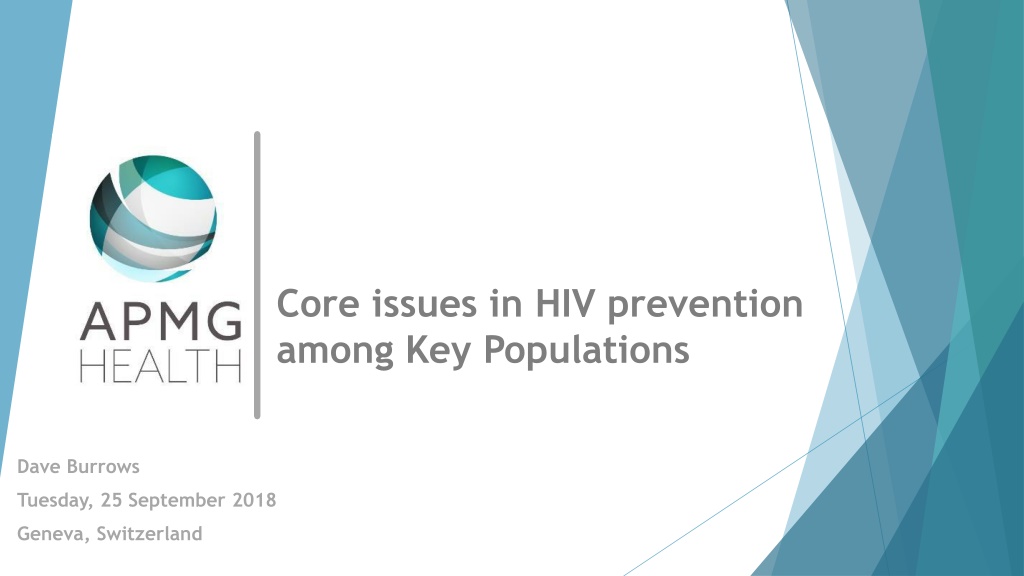
 undefined
undefined
